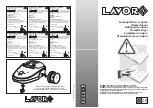
3
English
BATTERIES AND CHARGERS
The battery pack is not fully charged out of the carton.
Before using the battery pack and charger, read the
safety instructions below and then follow charging
procedures outlined. When ordering replacement battery
packs, be sure to include the catalog number and voltage.
The label on your tool may include the following symbols. The
symbols and their definitions are as follows:
V ......................... volts
Hz .......................hertz
min .....................minutes
or DC ......direct current
...................... Class I Construction
(grounded)
…/min ..............per minute
BPM ....................beats per minute
IPM .....................impacts per minute
RPM .................... revolutions per
minute
sfpm ................... surface feet per
minute
SPM ....................strokes per minute
OPM .................... oscillations per
minute
A .........................amperes
W ........................watts
or AC ...........alternating current
or AC/DC .... alternating or
direct current
...................... Class II
Construction
(double insulated)
no .......................no load speed
n .........................rated speed
......................earthing terminal
.....................safety alert symbol
.....................visible radiation
..................... avoid staring at
light
..................... wear respiratory
protection
..................... wear eye
protection
..................... wear hearing
protection
..................... read all
documentation
IPXX .................... IP symbol
Additional Safety Information
WARNING: ALWAYS
use safety glasses. Everyday
eyeglasses are NOT safety glasses. Also use face or
dust mask if cutting operation is dusty. ALWAYS WEAR
CERTIFIED SAFETY EQUIPMENT:
• ANSI Z87.1 eye protection (CAN/CSA Z94.3),
• ANSI S12.6 (S3.19) hearing protection,
• NIOSH/OSHA/MSHA respiratory protection.
WARNING:
Some dust created by power sanding,
sawing, grinding, drilling, and other construction
activities contains chemicals known to the State
of California to cause cancer, birth defects or
other reproductive harm. Some examples of these
chemicals are:
• lead from lead-based paints,
• crystalline silica from bricks and cement and other
masonry products, and
• arsenic and chromium from chemically-
treated lumber.
Your risk from these exposures varies, depending on
how often you do this type of work. To reduce your
exposure to these chemicals: work in a well ventilated
area, and work with approved safety equipment, such
as those dust masks that are specially designed to
filter out microscopic particles.
•
Avoid prolonged contact with dust from power
sanding, sawing, grinding, drilling, and other
construction activities. Wear protective clothing and
wash exposed areas with soap and water.
Allowing
dust to get into your mouth, eyes, or lay on the skin may
promote absorption of harmful chemicals.
WARNING:
Use of this tool can generate and/
or disperse dust, which may cause serious and
permanent respiratory or other injury. Always use
NIOSH/OSHA approved respiratory protection
appropriate for the dust exposure. Direct particles
away from face and body.
WARNING: Always wear proper personal hearing
protection that conforms to ANSI S12.6 (S3.19)
during use.
Under some conditions and duration
of use, noise from this product may contribute to
hearing loss.
CAUTION:
When not in use, place tool on a
stable surface where it will not cause a tripping or
falling hazard.
•
Air vents often cover moving parts and should be
avoided.
Loose clothes, jewelry or long hair can be
caught in moving parts.
• Do not use to vacuum combustible explosive
materials, such as coal, grain, or other finely divided
combustible material.
• Do not use to vacuum hazardous, toxic or carcinogenic
materials, such as asbestos or pesticide, unless the
vacuuming of the material is specifically identified in this
instruction manual as an approved use.
• Never pick up explosive liquids (e.g. gasoline, diesel fuel,
heating oil, paint thinner, etc.), acids or solvents.
• Static shocks are possible in dry areas or when the relative
humidity of the air is low. This is only temporary and does
not affect the use of the dust extractor.
• To avoid spontaneous combustion, empty the canister
after every use.
• Some wood contains preservatives which can be
toxic. Take extra care to prevent inhalation and skin
contact when working with these materials. Request
and follow any safety information available from your
material supplier.
•
NEVER STAND OR SIT ON DUST EXTRACTOR.
Serious
injury could occur if the dust extractor is tipped.
• When using with a manufacturer approved cart or trolley
use caution when moving to avoid tip-over.
• When stacking, always place the dust extractor on
the bottom.
• The handle is for transport only.
• Lift and carry the dust extractor by the handle only. If
mounted on a manufacturer approved cart or trolley,
transport using the cart or trolley handle only.






































